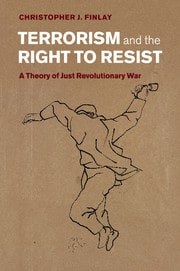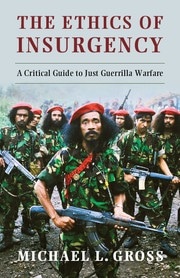 Terrorism and the Right to Resist: A Theory of Just Revolutionary War, Christopher J. Finlay (Cambridge, U.K.: Cambridge University Press, 2015), 339 pp., $103 cloth.
Terrorism and the Right to Resist: A Theory of Just Revolutionary War, Christopher J. Finlay (Cambridge, U.K.: Cambridge University Press, 2015), 339 pp., $103 cloth.

The Ethics of Insurgency: A Critical Guide to Just Guerrilla Warfare, Michael L. Gross (New York: Cambridge University Press, 2015), 337 pp., $93 cloth, $33.99 paper.
In the latter half of the twentieth century, lasting memories of two world wars and astonishment over the power of nuclear weapons left both policymakers and scholars of war largely preoccupied with the possibility of a catastrophic World War III. Instead, however, the face of war since 1945 has been that of regionally limited small wars and insurgencies fought with conventional weapons. Many of these conflicts began as armed rebellions against colonial regimes, but often later evolved into armed conflicts between and among various subgroups seeking control of state government. Such conflicts have usually been asymmetrical, with the party holding the reins of state power using aircraft, artillery, and armored vehicles, while those fighting against the regime have been limited to weapons that individuals can carry, such as automatic rifles, mortars, rocket-propelled grenade launchers, and improvised weapons of various sorts. The asymmetries have also typically gone deeper, with the fighters on the former side wearing uniforms and those on the latter often not; those on the former side making use of fortified bases and those on the latter side protecting themselves by blending in with the civilian population. Further, there have frequently been asymmetries in how each side has fought, with the militarily weaker side relying on stealth tactics, deception, and attacks against nonmilitary targets of more general public value, including direct attacks on people protected as noncombatants under the laws of war. The particular range of tactics classified as terrorism begins at this point, with the specific, direct, and intentional targeting of noncombatants. Such attacks not only have been the means of choice for transnational nonstate actors, including al-Qaeda and the self-styled Islamic State, but have also been used to considerable effect in local civil wars.
Such has become the general face of war over the last seven decades. Yet while insurgency warfare is by no means a new phenomenon—though it has manifested itself in different ways throughout history—present-day insurgency warfare reflects specific recent political and social attitudes, and proceeds from its own moral and theoretical bases. It is into the ongoing debates over contemporary insurgency warfare that Christopher J. Finlay and Michael L. Gross have placed themselves.
Full essay available to subscribers only. Click here for access.
More in this issue
Fall 2017 (31.3) • Review
Power Shift: On the New Global Order by Richard Falk
Richard Falk’s most recent book is full of interesting insights and displays an impressive degree of rhetorical power. Collectively, these essays demonstrate, rather convincingly, ...
Fall 2017 (31.3) • Review Essay
Poverty Alleviation, Global Justice, and the Real World
For nearly half a century, political theorists have wrestled with the problem of global social justice, producing ever more elaborate and analytically-sophisticated models, but without ...
Fall 2017 (31.3) • Feature
“Utopian in the Right Sense”: The Responsibility to Protect and the Logical Necessity of Reform
In this article, Aidan Hehir writes that claims made about the success of the Responsibility to Protect (RtoP) echo the pejorative conceptions of “utopianism” as ...